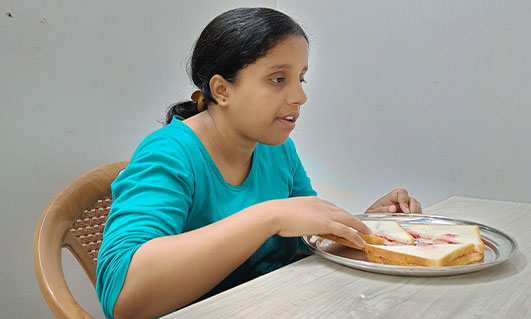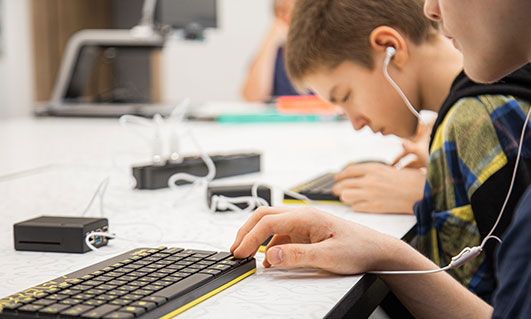The experience of blindness can vary depending on the individual and the cause of their visual impairment. It’s important to note that blindness refers to a significant loss of vision or the inability to see, rather than a uniform experience shared by all blind individuals.
Here are a few scenarios that may help understand what blind people may see:
Total blindness: Some individuals who are totally blind may perceive complete darkness or blackness. They may not have any visual sensations or perceptions of light, color, or shapes.
Light perception: Some blind individuals may have the ability to perceive light but not discern specific objects or shapes. They may see variations in brightness or changes in light, but without the ability to distinguish visual details.
Tunnel vision: Some people with visual impairments may have a condition known as tunnel vision. In this case, they have a restricted field of view and can only see objects or shapes within a narrow central area, while the peripheral vision is significantly diminished or absent.
Blurred or distorted vision: Certain eye conditions or diseases may cause blurred or distorted vision, leading to an unclear or hazy perception of the surrounding environment.
Partial vision or low vision: Some individuals with visual impairments may retain a certain level of vision, referred to as low vision. They may be able to perceive shapes, colors, or high-contrast objects, but their visual acuity is significantly reduced and may require visual aids or adaptations for daily activities.
What they see

It’s important to understand that blind individuals, depending on the cause and extent of their visual impairment, may not “see” in the way that sighted individuals do. Visual perception is primarily a function of the eyes and the visual processing centers in the brain. When someone is blind, the visual system does not function as it does in individuals with normal vision.
For someone who is totally blind or has no light perception, they do not see any visual stimuli. They do not perceive light, shapes, colors, or any visual information. It’s akin to seeing complete darkness or being in a pitch-black room.
For individuals with some residual vision, such as those with low vision, their visual perception may be limited, blurry, or distorted. They may have difficulty discerning details, recognizing faces, or reading small print. They may see objects or shapes, but their visual acuity and clarity are significantly reduced.
It’s important to note that blindness is not simply a matter of “seeing nothing.” Blind individuals may still have rich sensory experiences through their other senses, such as touch, hearing, smell, and taste. They develop alternative methods of perceiving and navigating the world, relying on auditory cues, tactile feedback, spatial awareness, and the input from their other senses.
It’s also worth mentioning that blind individuals can have diverse experiences and abilities, and their individual experiences of vision or lack thereof can vary. Some individuals may have residual vision or regain partial vision through medical interventions or visual rehabilitation programs. Consulting with blind individuals, organizations, or professionals who specialize in working with the visually impaired can provide deeper insights into their experiences.
Blind regular day?

Blind individuals navigate their regular day using a combination of non-visual techniques, adaptive strategies, and assistive devices. Here are some common approaches and tools they may utilize:
Orientation and mobility techniques: Blind individuals often receive training in orientation and mobility, which involves learning how to move safely and confidently in their environment. They use various techniques such as using a white cane, using sound cues to identify landmarks and intersections, and employing spatial awareness to navigate their surroundings.
Guide dogs: Some blind individuals choose to work with guide dogs specially trained to assist them in navigating their environment. These highly trained dogs provide mobility support, helping their owners avoid obstacles and navigate busy streets.
Assistive technology: Blind individuals utilize various assistive devices and technology to enhance their independence and access information. These can include screen readers and Braille displays for computers and smartphones, speech-to-text software, tactile markers or labels, and accessible electronic devices designed with non-visual interfaces.
Braille: Many blind individuals learn Braille, a tactile writing system consisting of raised dots. They can read Braille using their fingertips, allowing them to access written information, including books, documents, and labels.
Auditory cues: Blind individuals rely on auditory cues to gather information about their surroundings. They listen for sounds such as traffic, footsteps, or environmental sounds to gauge their location and make informed decisions.
What struggle blind regular day
Blind individuals can face various challenges in their regular day-to-day lives. Here are some common struggles they may encounter:
Navigating public spaces, buildings, and transportation systems can be challenging for blind individuals. Inaccessible infrastructure, such as lack of tactile paving, poor signage, or inaccessible websites and digital content, can hinder their ability to move around independently and access information. Blind individuals may face difficulties in using public transportation systems, especially if they are not equipped with proper audio announcements, tactile markers, or trained staff. Identifying bus stops, train platforms, or hailing taxis can be challenging without visual cues.
Blind individuals may encounter barriers in accessing information presented in visual formats. Printed materials, visual displays, and online content without proper accessibility features can limit their access to important information, such as announcements, documents, or educational materials.Blind individuals may face challenges in social interactions, particularly in situations where visual cues are relied upon for communication. Recognizing familiar faces, interpreting non-verbal cues, or participating in visual activities can be more challenging.
Blind individuals may face additional hurdles in daily living tasks, such as cooking, organizing personal belongings, or managing household chores. Adapting to a non-visual approach and utilizing assistive devices or techniques can require additional effort and adjustments.Blind individuals may face barriers in accessing employment opportunities due to misconceptions about their abilities, lack of accessibility in work environments, or limited access to assistive technology or accommodations.
It is important to note that while blind individuals may encounter challenges, many are resilient, resourceful, and actively seek solutions and support systems to overcome these difficulties. Accessible environments, inclusive policies, advancements in assistive technology, and societal awareness can play crucial roles in reducing these struggles and promoting equal opportunities for blind individuals.





